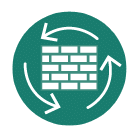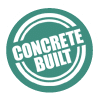![]()
Did you know Concrete & Quarried Materials Account for just over 3% of Overall House Building Costs
In March 2018 ICF (Irish Concrete Federation) commissioned a report into the cost of concrete and quarried materials used in new house construction.
The key findings from this research are that:
1. The basic construction materials supplied by quarry operators, readymix concrete suppliers, concrete block and other product suppliers account for just 3.2% of the cost of building the most common form of new house in Ireland – the three bedroomed semi-detached house. This new house building cost excludes the cost of site purchase;
2. Including site costs, the basic construction materials account for just 2.6% of the total cost of providing a standard three-bedroom house in the Greater Dublin Area;
3. The costs of these forms of construction materials have been relatively steady since 2010.
To read the full report please click here.
 Built to Last
Built to Last
Concrete buildings are built to last and to be flexible and adaptable, meaning that buildings can be easily reconverted and internal layout can be easily changed to accommodate any design, thereby reducing the environmental impact of concrete over its lifetime.
 Fire Safe
Fire Safe
Concrete is non-combustible, thereby ensuring its longevity, protecting lives and reducing the economic damage caused by fires. Concrete is designated by the European Union as a Class A1 building material (non-combustible).
 Energy Efficient
Energy Efficient
Concrete’s thermal mass reduces energy consumption and moderates internal temperatures thereby reducing costs. As the use of buildings accounts for the largest part of their environmental impact, thermal mass in buildings offsets the impact resulting from the production of concrete itself. As concrete buildings have very few joints or connections and maintain their structure over time, air-tightness is achieved, which also saves energy.
 Comfortable
Comfortable
Concrete offers excellent acoustic performance requiring very little additional materials and improving quality of life particularly in high-density housing or near busy roads.
 Resilient
Resilient
Concrete retains its structural integrity in a flood, reducing disruption to homeowners, businesses and the community and minimising repair costs. This reduces waste of materials and downtime of homes, businesses and essential community services.
 Recyclable
Recyclable
At the end of a long life, the concrete can be recycled thereby reducing environmental impact and preserving raw materials for future generations.
 Local
Local
Concrete and its raw materials – aggregates, cement and water are locally available, thereby reducing transport emissions and distances to the construction site, when compared to imported materials such as steel and timber. Concrete is a local business, creating local jobs and wages are pumped back into the local economy.

Concrete is built to last and concrete buildings can remain serviceable for hundreds of years.

Concrete is designated by the European Union as a Class A1 building material (non-combustible).

Concrete is 100% recyclable.

‘Fabric First with Concrete’ – The first step to maximise the buildings performance!